AI has taken over search to the point where it’s now more likely that a patient searching online will be looking at an AI result than not. It’s not just Google’s AI Overviews at the top of the results page; it’s also people using Google’s AI Mode and Gemini, or searching with Perplexity, or asking their questions directly to ChatGPT. AI-generated answers are now the default search results.
Table of Contents
If your brand isn’t appearing in AI-generated results, you’re not even in the consideration set. As more patients rely on AI overviews and summaries, traditional SEO visibility no longer guarantees traffic or bookings.
That presents a problem for healthcare marketers: Anyone still focusing only on traditional search rankings is missing out on an ever-increasing chunk of patient traffic. But the AI search revolution brings new opportunities for those who can adapt. We’re still building on a lot of those same SEO foundations, but the goalposts have shifted. AI isn’t looking for keywords, it’s looking more broadly at what’s semantically relevant. We’re no longer optimizing for clicks; we’re optimizing for recommendations.
I know a lot of healthcare marketers are wondering how to stay competitive in this new AI landscape, so I wanted to lay out where we are now, what types of strategies you should be thinking about, and some specific tactics that we’ve had success with.
AI Search Has Changed the Game
“The zero-click experience is really evolving. So what do we do with that information? How do we track that information, and how important is that to still winning business?” —Lauren Leone, Chief Growth Officer, Cardinal Digital Marketing
The first thing to know is that Google’s AI overviews appear right at the top of search results and eat up half of the page—or almost all of it on mobile. Users aren’t seeing 10 blue links. They’re seeing an AI recommendation summary that synthesizes the best sources, and that’s where a lot of them stop. For many queries, users aren’t scrolling or searching further for more answers; they’re just trusting the AI summary. That’s now the front door for healthcare provider discovery.
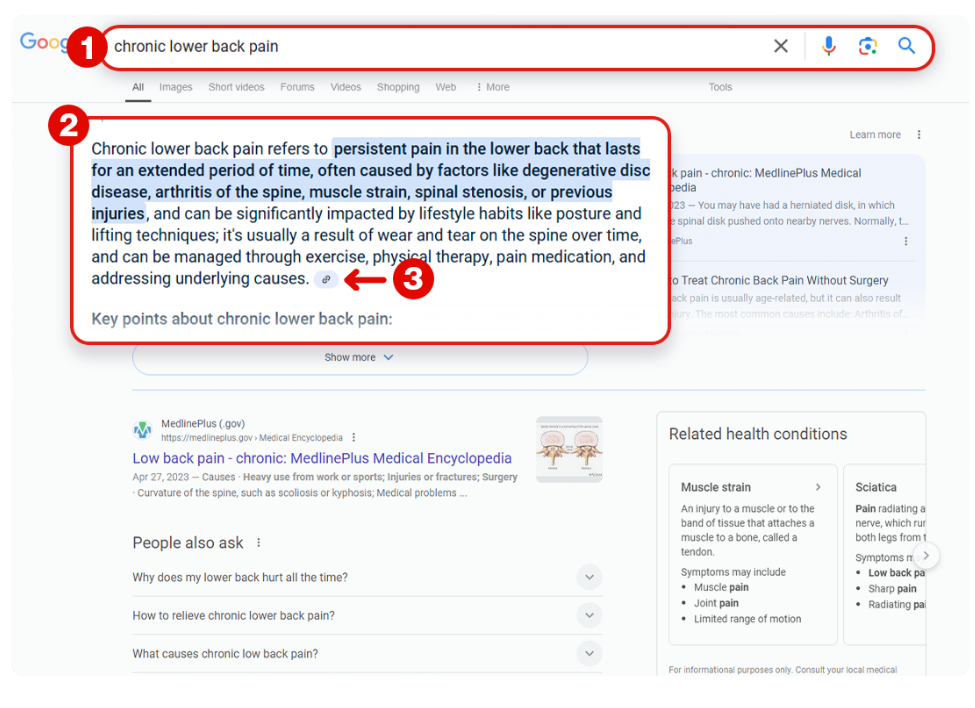
Google’s integration of generative AI into search has accelerated rapidly this year. Since March, the SERP features for non-branded SEO have tripled for many organizations in the healthcare space. When a patient types “best urgent care near me with short wait times”, instead of a map pack, they now see a bulleted recommendation pulled from AI. And that recommendation is often based not just on your Google Business Profile (GBP), but on reputation, reviews, and 3rd-party content. So you do need to be shifting your strategy to account for this massive shift in the landscape.
Strategy:
- Start tracking AI visibility. Get monthly reports (branded and non-branded) to see how often you show up in AI overviews (more on how to do this below).
- Shift your SEO mindset from “how do I rank?” to “how am I described?” Remember that you’re no longer just a link; you’re being described to users by the AI.
GenAI Is a Recommendation Engine, Not A Search Engine
Where traditional search engines just ranked websites in a list of links, generative AI provides summaries and looks at all the contextually relevant information. The result is that traditional SEO signals like keywords are less important for AI. There was a study that just 5.4% of AI results contained the “exact” query of a search, so keyword density is really taking a back seat to intent.
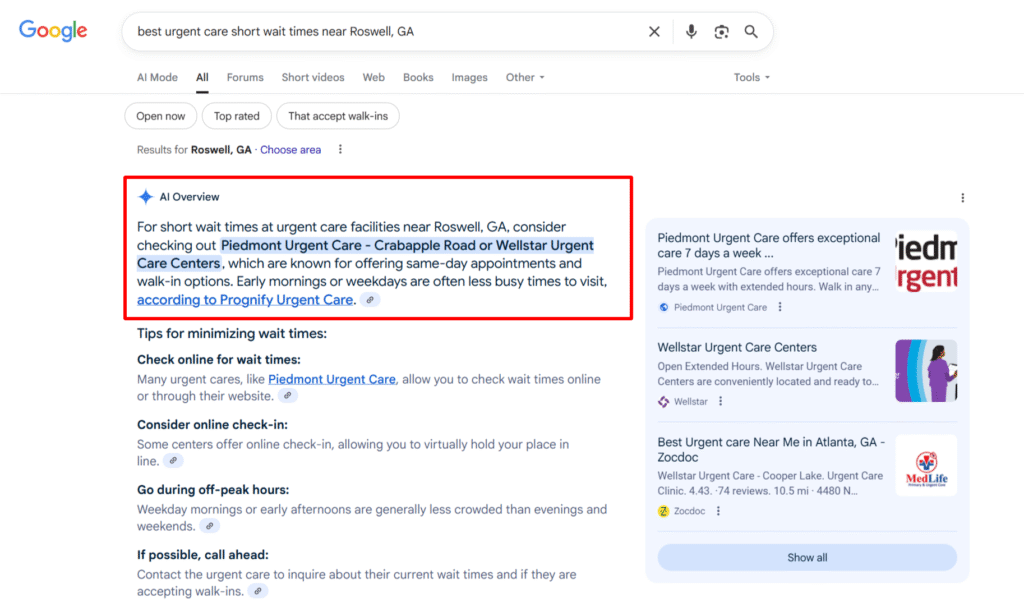
Instead, AI is using inputs from all over the place to form impressions, including some that you might not expect. Like Glassdoor, it’s probably not one of the first sites patients go to when researching a hospital. But AI is going to pull data from there, so in addition to summarizing the quality of the care and patient reviews, it could also notice really high turnover rates or unhappy providers. Reddit is a big source for some AIs, so Perplexity might describe you as “known for poor billing practices” based on Reddit comments, even if your website promises easy billing.
There have even been some recent tests in the SEO space that show creating and updating your Google Business Profile images has an effect. Some people tested adding words to the image, like a little display banner instead of just a picture, and the theory is that Google is using AI to look at images and get context from images.
So it’s helpful to look beyond keywords and start thinking more broadly, because AI will certainly be looking more broadly when putting together its summaries.
Strategy:
- Look beyond visibility to sentiment and consider what the AI is saying about you.
- Run prompts like: “What are the best physical therapy clinics in Atlanta?” or “Why do people like [Brand Name]?” Analyze where the info is pulled from and then reverse-engineer the sources that shaped the AI’s answer.
Align SEO to Business Strategy, Not Just Rankings
One of the interesting results of AI shifting SEO more towards recommendations than rankings is that a lot of that click-gamifying and frantic link buying/building from previous SEO is now falling by the wayside. We’re looking at more of a value-based structure, which really changes the priorities.
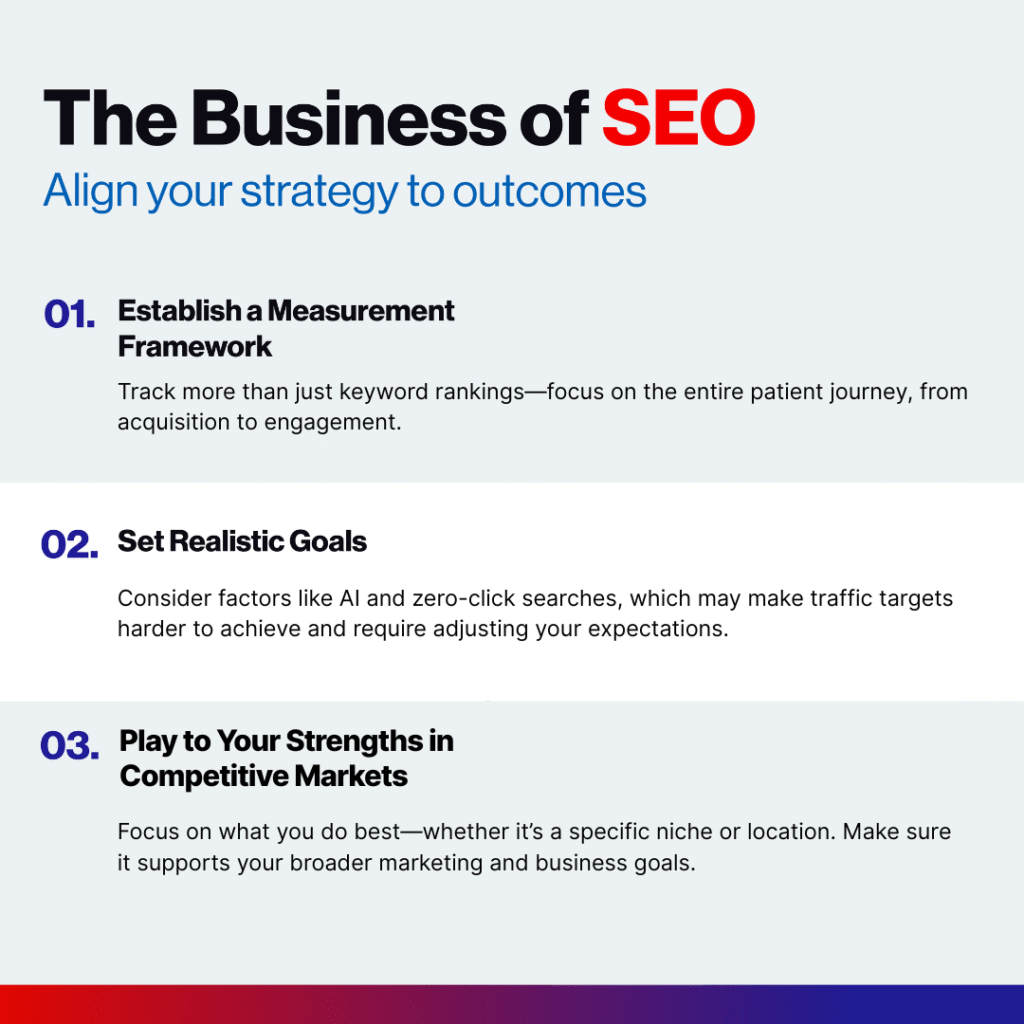
Quality Over Quantity
Rather than just trying to maximize the number of backlinks and fight for rank, you’re fighting for a recommendation and want to be more focused on getting those local links that show you’re connected in that community. We’re seeing a lot of importance come back to PR, because you’re not just jockeying for position, you’re trying to earn that recommendation.
It’s different from Google SERP, where that first spot is 30% click-through rate and the second spot is half that, and then a third, and then it trails off. For ChatGPT citations, it starts just under 10% at the top spot, and you see a much more even distribution, where by the time you hit rank 7, the actual ChatGPT citation is higher than the human click-through rate.
So it’s less about fighting for that top spot, and more about making sure what AI is learning about you is good content in a way that aligns with your patient acquisition goals. You want a measurement framework that’s not just looking at rankings and traffic, but also at leads, bookings, engagement, and visibility in AI prompts.
Strategy:
- Drive Trust – don’t just maximize page and backlink quantity. Bring authority and leverage partnerships to create impactful content that earns trustworthy links.
- Align to your marketing strategy – identify the business goals and execute digitally.
Differentiation Is Essential
Differentiation has become a lot more important because you want to provide that hook so the AI has something relevant to say about you. And it’s equally important for people who find you in their AI search and want to learn more about you. Just being close and having doctors that can provide care is not enough anymore in healthcare. That’s just table stakes. You’re dealing with consumers who are more intentional in their search and want to know what differentiates you. And the answer to that question is something that should be very much aligned with your Go-To-Market strategy.
Almost every hospital in America probably knows how it compares to the two or three other hospitals nearby. Are they the most clinical? Are they the best experience? Are they the most compassionate? Are they priced better? It doesn’t have to be a fantastically original USP (although great if you have one), but it’s really important right now to have something that differentiates you, that the AI can recommend, backed up by things like reviews. Figure out what it is that only you can say, and then say it.
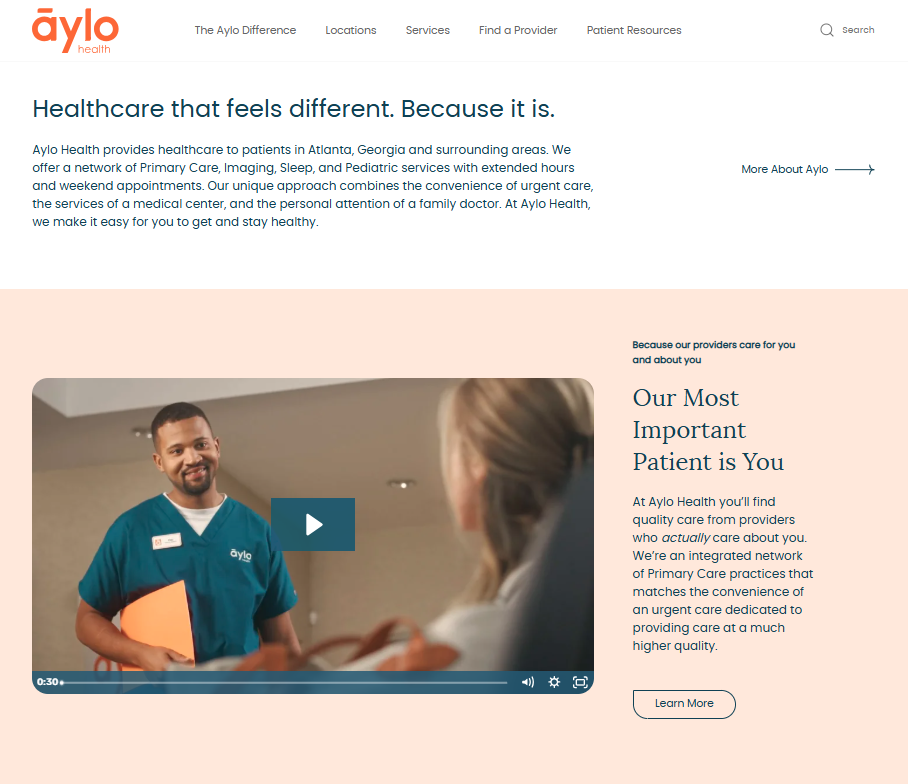
Strategy:
- Play to your Strengths – focus on what you do best so the AI can help differentiate you.
- Prioritize Keywords – you can’t rank for everything, so focus on keywords/services/patients with the highest returns.
Give AI What It Wants
82.5% of content cited in AI results comes from deep-linked long-form content, a statistic that will probably come as a surprise to anyone used to traditional SEO, where you wanted to have keyword-stuffed content closer to the root.
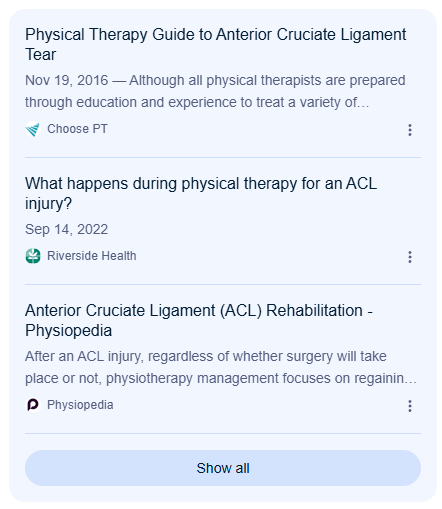
But AI isn’t traditional SEO.
What AI search wants is specialized and specific content that isn’t just a copy of what’s being said everywhere else. So that means rather than just dumping in fluff that’s filled with keywords, you really need robust content written with intent. Helps if it’s well-linked and well-articulated too, but having that specialized first-party content is what signals to AI that you’re a valuable source.
Also worth noting that because AI is often pulling just 100-300 words into its summaries to answer user questions, it’s helpful to structure your content in such a way that most of your few-hundred-word chunks could stand alone without needing the rest of the page for context. You might have noticed that’s even how I’m doing things in this article, conveniently breaking everything down into short sections that cover a single idea. Handy for people scanning quickly, as well as AI.
What AI Wants:
- Easily digestible content chunks (1-3 short paragraphs that cover a single idea that could be quoted by AI)
- Structured formats (FAQs, Tables, H1/H2/H3 structures)
- Unique content written with intent and specificity (not fluff or keyword stuffing)
- First-party insights, data, and expert POVs
- Claims backed immediately by evidence in the same chunk
- Reviews, Reddit posts, and non-obvious sources
- Query fan-outs – related questions users might ask (definitions, evaluations, etc.)
- Less spam. More clarity, credibility, and comprehensiveness
Traditional SEO Optimization Is Still Relevant
AI is still new enough that there’s no universally agreed-upon equivalent term to SEO. I’ve seen Generative Engine Optimization (GEO), AI Inclusion Optimization (AIIO), and Answer Engine Optimization (AEO), just to name a few. Whatever you call it, there are several key differences from traditional SEO that should inform your larger strategy.
But don’t make the mistake of thinking that the rise of GEO/AIIO/AEO means that traditional SEO is no longer important. Most AI citations come from the top 12 organic results, so strong SEO still very much matters even if it’s not driving clicks in the same way it used to. And many of those same SEO fundamentals are still quite relevant.
SEO Fundamentals you still need:
- Core Web Vitals – your site should load fast, perform well, deliver a good user experience
- Site Architecture – logically arranged navigation with clear URL structures (now with AI Schema)
- Interlinking & Metadata – optimize SERP result experience and content authority structures to drive visibility + engagement
- Crawlability & Indexability – ensure engines can access, understand, and rank your pages (now LLMS.txt should join robots.txt)
- Local Search – local listings with w/photos and reviews are still crucial for high-intent searches
Measurement Is Evolving Rapidly
Compared to something like traditional SEO where Google has 90% of the market and then second place is Bing with 4%, AI is a little trickier to measure because there are more relevant platforms to consider. There are seven or eight platforms that have a significant market share at the moment, and you definitely want to be measuring across multiple platforms. And what you’re looking to measure are what I call the “3 Ps”: Presence, Perception, and Performance.
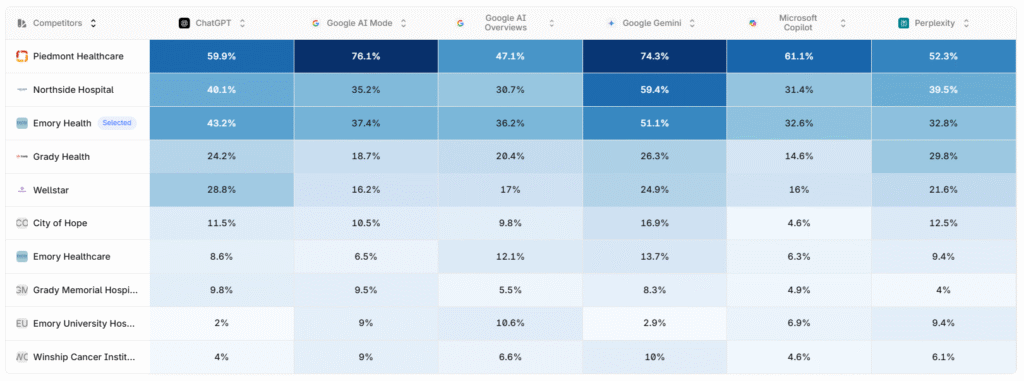
Presence
How often are you cited in AI outputs? You can track your raw number of brand mentions, visibility from how often your brand is mentioned in response to a prompt, and your voice share of all brand mentions across AI-generated responses. This type of brand visibility is the closest thing AI has to search rankings, and you can track it either with dedicated AI tools like Profound.ai and YEXT Scout, or you can manually just open up a whole bunch of tabs of different platforms and search different prompts.
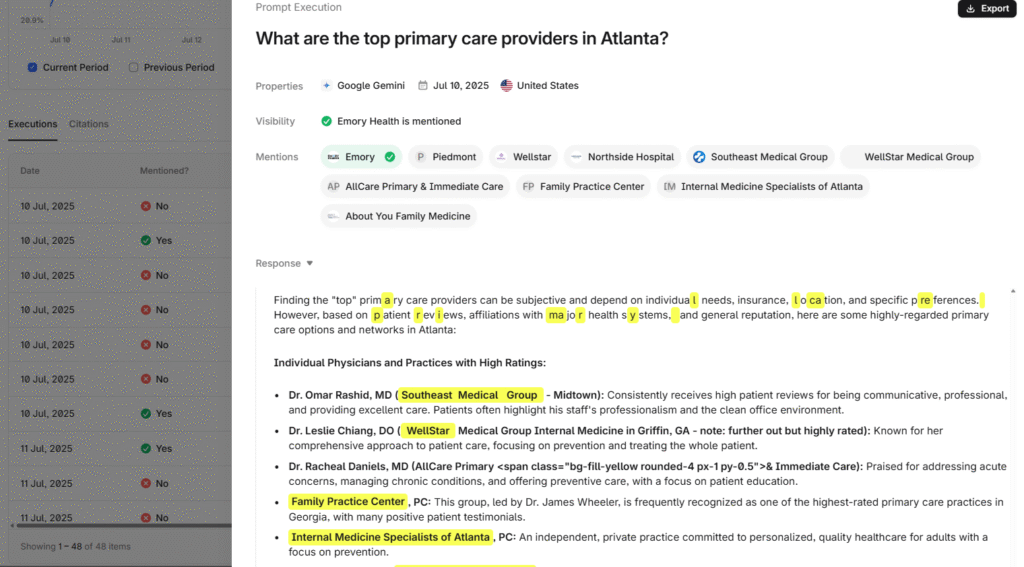
Perception
Are you seen as helpful, trustworthy, and differentiated? This relies on many other off-site mentions of your brand, and by measuring sentiment analysis you can track not only your favorability percentages, but also what are the main things driving those AI recommendations and what are the biggest negatives that people are mentioning. Measuring this is a great opportunity for organizations to keep an eye on things, see what positive differentiation you might want to lean into, and see what negative perceptions you need to manage better.
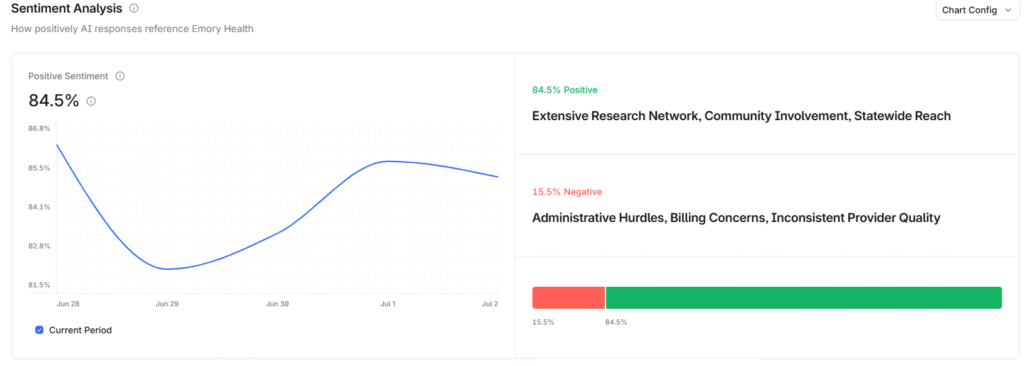
Performance
Are those AI referrals converting into real leads and patients? It’s worth measuring not just the number of sessions that mention your brand, but how many of those turn into leads and then your conversion metrics from AI referral traffic.
Measuring these three Ps, along with more general prompt volume analysis, will give you valuable insight into where you stand in the AI-search landscape.
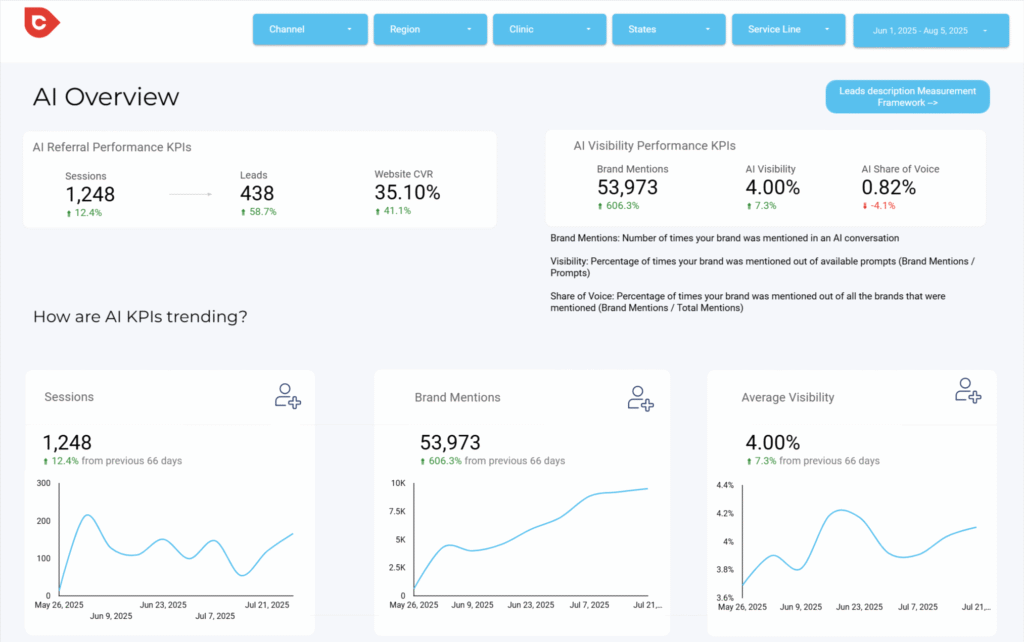
Strategy:
- Start with monthly prompt tracking (10–15 core queries) and track visibility + referral KPIs
- If you can’t justify the expense of a measurement tool, just manually search a few prompts to see who is showing up and who isn’t.
- Document results over time and create a slide deck for internal sharing
- Compare pre/post-updates to content and site structure to see if perception shifts
- Track competitor visibility and sentiment for valuable competitive insights
“Really thinking about your content and using the data that you get from those AI tools around the prompting trends to inform your content strategies. And then you’ve got to work on any perception gaps — take those to your ops team and start to bring them that data and talk about, as an organization, how you’re going to tackle those things.” —Lauren Leone
AI Optimization Tactics We’ve Tested
Once you start digging into AI recommendations and results you can pull out a lot of great insights that you can leverage to update your content strategies. A few client examples I can share:
Publish “best doctors in NYC for XYZ” content to match common “near me” AI queries
The AI favors individual doctors and providers for “near me” results over brand searches. It also looks for stories and reviews that highlight the value of those individual providers. When we ran AI queries on those prompts, the results returned were mainly for specific doctors, while our multi-site client only had content about the brand. To rank for AI searches, we pivoted from brand content to creating doctor-specific content and keyword-aligned support articles.
Promote strong reviews on negative sentiment topics
We had a client who was tracking perception and saw a trend of negative sentiment around billing complexity. This client happened to have a high review volume that was mostly positive, so we had reviews that spoke positively of the billing experience. We prioritized publishing and making those strong reviews more visible to feed positive sentiment on that topic to the AI, and then encouraged the client to solicit more reviews from patients to further influence AI recommendations.
Don’t just say “dentist”
One of our clients was dominating “dentists near me” in SEO, but when it came to AI, they weren’t ranking at all. We wondered why that was, and it turned out certain AI platforms read the term “dentist” as a human and not as a dentist office or a dentist brand. So we found that we needed to start writing some content about “our dentists” and the dentists in this community, and what they’ve been able to achieve.
That last one may be an odd example, but if you want to rank for AI, you really have to dive in to understand the logic. Take a look at it, understand how it gathers information and what it is actually displaying, and that can help you understand the best ways to optimize for it.
Pro Tip:
A great way to learn how to optimize for AI is to ask it directly.
When using AI engines like Gemini or Perplexity to see if you show up in a prompt, ask follow-up questions like:
“Why did you recommend these brands?”
“Why didn’t you show mine?”
Unlike Google search, where Google carefully guards the secret of its black box algorithms, AI tools are often happy to explain their logic. They’ll come right out and tell you that your brand wasn’t as localized in the environment, or that you didn’t have as much content depth or perceived expertise. You can even ask for a table or ranked criteria list to have it weighted by importance, which is tremendously useful if you’re trying to figure out why you’re not appearing in the AI searches you think you should.
AI Search Could Be A Good Thing
There’s no question that AI has disrupted the world of healthcare SEO, but in many ways, it presents a great opportunity. AI makes it harder for healthcare orgs to just brute force search results by pumping out random content, so you really need to double down on specificity, trust, and differentiated content. It’s an opportunity to figure out why your patients love you and recommend you, because that’s the story you want to start telling more aggressively and having it backed up in reviews and PR.
And if you can do that research and get your organization behind you—getting 1p data to help choose what to show expertise in and collaborating with doctors/nurses as content providers—it’s a great chance to start telling your story in a compelling way in the SEO space. Once you can stake out what differentiates you and earn those recommendations, the brands that get cited in AI are the brands patients will remember.

